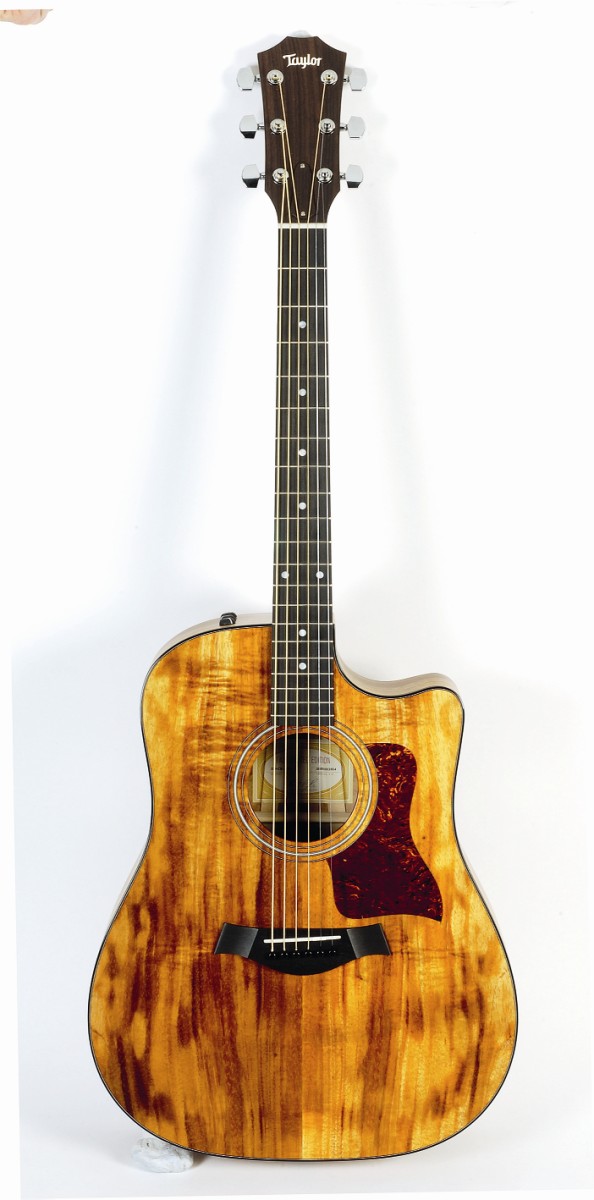MusicRadar Verdict
A very accomodating instrument with a distinct sonic and visual charm.
Pros
- +
Usual precision Taylor construction. Faultless action. Good price for such a feast of koa.
Cons
- -
The koa grain can create a patchy look. Nothing else really.
MusicRadar's got your back
Taylor's 320ce-L10 dreadnought is a cutaway electro-acoustic. The interior is typically spotless, although not finished as immaculately as small-scale high-end makers' instruments.
Whether this matters or not is open for debate, but what's for sure is that Taylor's increasingly hi-tech production methods have, on many other levels, surpassed what the finest traditional craftsman can achieve.
Overview
When Taylor took the decision to re-voice its dreadnoughts back in 2003, it was only from the 500 Series upwards, so it's the same scalloped X-bracing that's been used for some time that you'll find here. Decorative appointments are standard, but the mottled and streaky golden and dark brown koa top creates a different vibe.
Typically, the black/white wood fibre soundhole rosette is perfectly clean cut; as is the top's two-ply perimeter purifing. Body binding is black fibre. Back and sides are left plain, with only a black fibre strip along the sides' end-joint. The three-piece back makes productive use of book-matched slices of koa that are otherwise too narrow.
The neck, as you may probably know already, is a three-piece construction (heel/shaft/headstock), designed to conserve Taylor's precious mahogany stockpile. Fresh supplies of genuine South American mahogany are now pretty much as difficult to obtain as Brazilian rosewood.
You may also be aware of Taylor's NT neck, which involves a complex yet invisible system of neck strengthening and jointing to obtain ideal alignment and end-to-end fingerboard evenness.
As usual, the fingerboard and frets are immaculately presented and the nut sits neatly and squarely. At the top you'll find the standard 300 Series rosewood headstock veneer and the generic Taylor chrome tuners, which are solid, but not (under tension) the smoothest-geared machines available.
Unlike many makers, Taylor finishes its ebony bridges almost as finely as its fingerboards, and the saddle is perfectly snug and perpendicular. You even get ebony bridge pins.
Having spent years of research and heartache perfecting its environmentally friendly and timesaving UV-cured finish, you can rely on Taylor to offer an utterly pristine coating for its instruments.
Taylor's stealthy and painstakingly R & D'd Expression System is pretty well established among players now. Its three properly dynamic sensors (shunning both piezo-type materials and under-saddle placement), balanced low-impedance output, simple yet studio-quality EQ and even its low-profile non-slip control knobs give it several fundamental advantages over typical electro-acoustic systems.
With a shallow modified 'C'-profile cross-section that barely tapers - just over 21mm (first fret) to just over 22mm (10th fret) - and the wider of the two most common widths, this neck feels both svelte and spacious.
A perfectly silken ebony fingerboard with properly buffed frets and the mahogany's particularly slippery satin finish combine to deliver an exceptionally fast interface.
Visual impact
Taylor's NT neck resolves many age-old acoustic neck issues, with its textbook neck alignment and end-to-end fingerboard evenness; and you immediately appreciate how the intelligently judged factory-set action is effortlessly low yet consistently clean-fretting.
The neck joint's inherent adjustability ensures it will stay this way for the life of the instrument. If you're planning on venturing up into the cutaway region, you'll find the intonation sweet enough, but the (albeit unavoidable) positioning of the pre-fitted heel-mounted strap button will irk some.
The Hawaiian koa body has a strong visual impact compared to the Sitka spruce and African mahogany of the standard 310ce, but the tonal shading proves subtler since Taylor's prevailing 'house tone' still dominates the overall character.
Koa is harder and denser than spruce or cedar, so for the soundboard Taylor will have partially countered this by adjusting the thickness. However there's more sustain and sweetness, but less dynamic attack and a narrower frequency response, with less widespread harmonic lushness.
Like mahogany-topped acoustics, this purer, earthy flavour has a charm of its own. Taylor places koa backs and sides somewhere between maple and rosewood in the tonal spectrum, while others liken koa to mahogany, but either way the back and sides certainly add to the distinctive voice we're hearing. Not a radical departure, but an interesting and temporary tonal option for the 300 Series.
And crucially, the Expression System's sensors are quite capable of capturing tonal and dynamic nuances as rarified as these, so the plugged-in sound also reflects these koa-tinted variations.
While it still offers a slightly modified translation of the acoustic tone, the ES accurately tracks the natural dynamics of your playing too, which makes a big difference.
Why is tennis superstar Serena Williams being bombarded with microphones fired from confetti cannons? Allow us to explain…
Carlos Santana collapses and then cancels second show “out of an abundance of caution”
“Every post feels like a test. If it flops I feel like a failure”: 61% of DJs feel that their social media presence is more important than their skill










